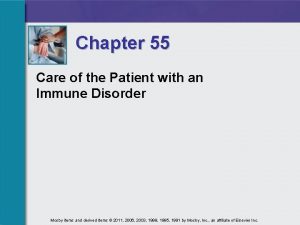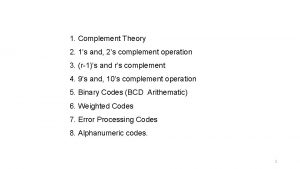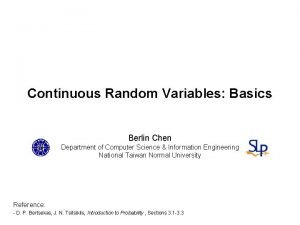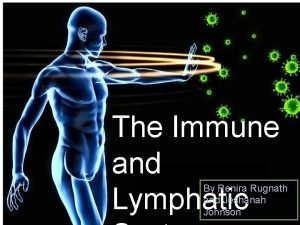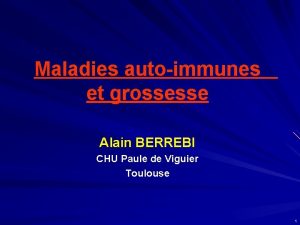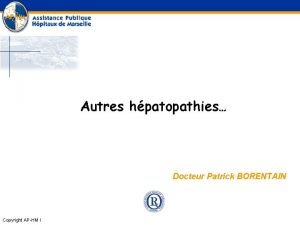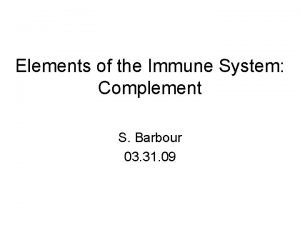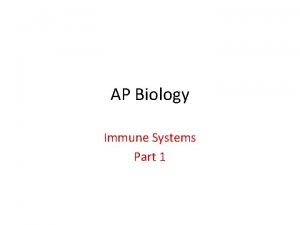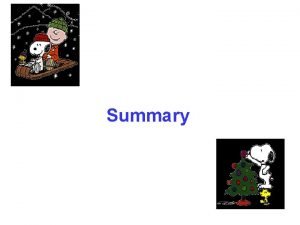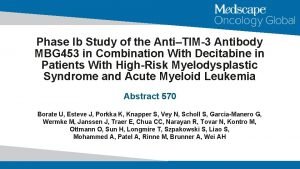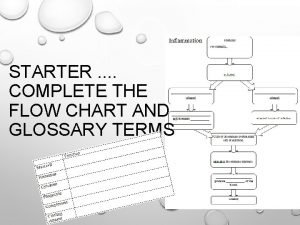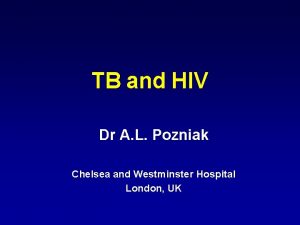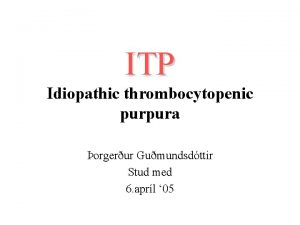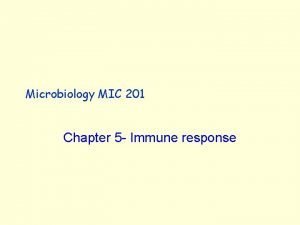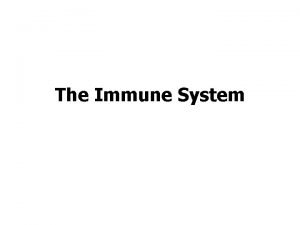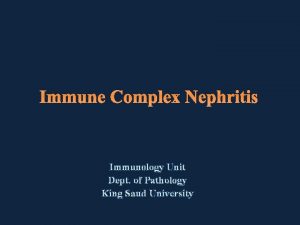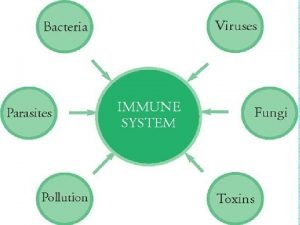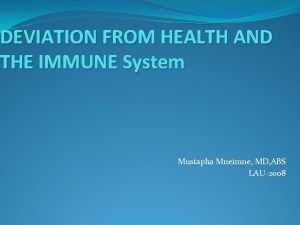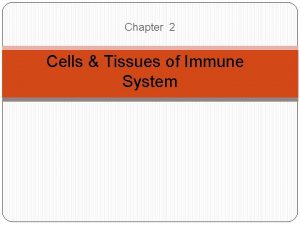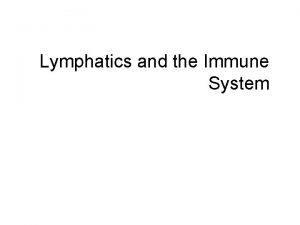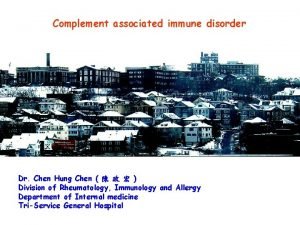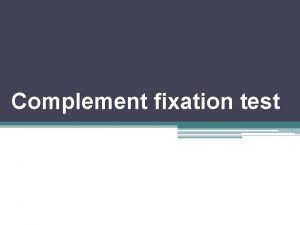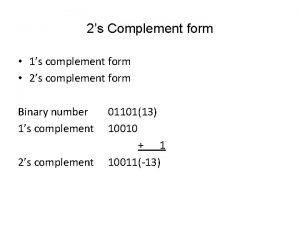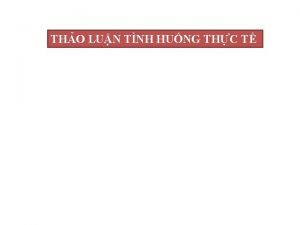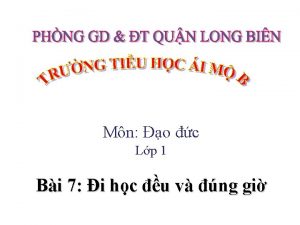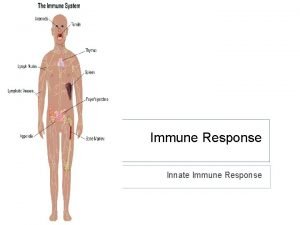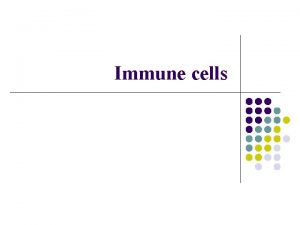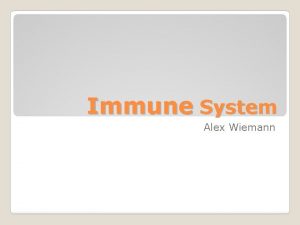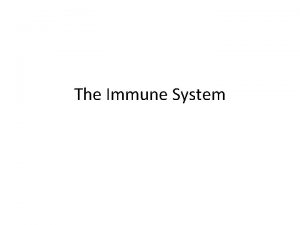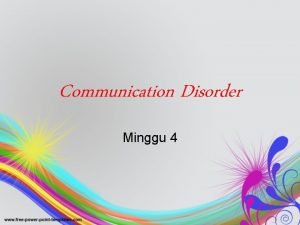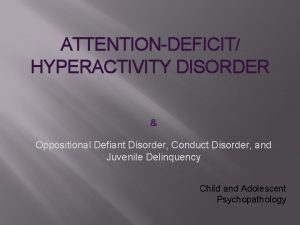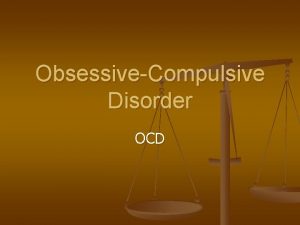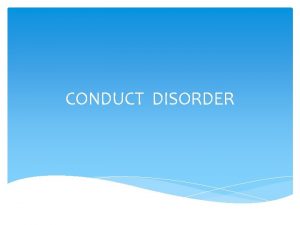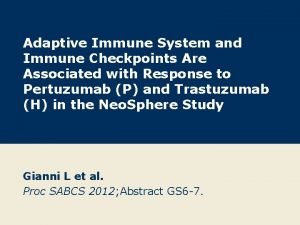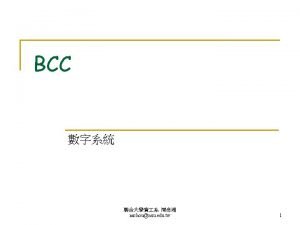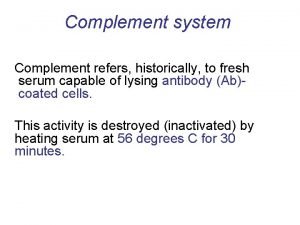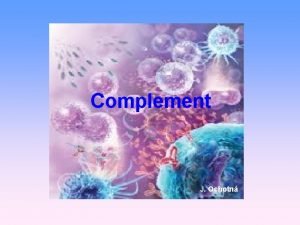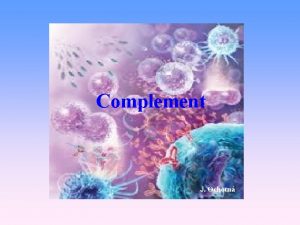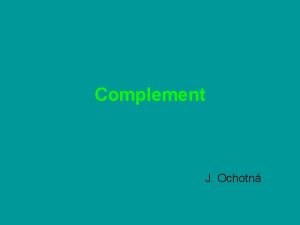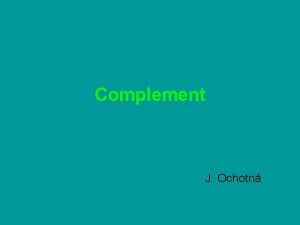Complement associated immune disorder Dr Chen Hung Chen




































- Slides: 36

Complement associated immune disorder Dr. Chen Hung Chen ( 陳 政 宏 ) Division of Rheumatology, Immunology and Allergy Department of Internal medicine Tri-Service General Hospital

Introduction of Complement system: Definition: • A group of sequentially reacting proteins, which upon activation, mediate a number of biological reactions important to host defense Nomenclature: • • • “C”-designation for 11 of complement proteins( C 1, C 2, etc) “Factor”-designation for many alternative pathway components( factor B) Overbar-indicates an enzymatically active protein or complex Lower case letters-indicates a proteolytic cleavage fragments(C 3 a, C 5 a) “R”-designation for receptors in the complement system(CR 1, CR 2)

Complement Biosynthetic Sites • • • Hepatocytes Monocyte/Macrophage Hematopoietic Fibroblasts Endothelial Reproductive Adipocytes Astrocytes Neurons

Modular Structure of Complement Proteins • Enzymes-(Serine Protease Domain) C 1 s, C 1 r, C 2, MASP 1/2, factor B, D, I • Collectins-(Collagen Stalk, Gobular Domain) C 1 q, MBL, Ficolin • Cytolytic-(C 9/Perforin Domain) C 6, C 7, C 8, C 9 • Regulatory and Receptor (SCR Domain) DAF, MCP, C 4 BP, CR 1 & factor H • “True” Complement Proteins C 3, C 4, C 5

Protein of the Complement System Serum Soluble Membrane Bound Activation Regulation C 1 q, C 1 r, C 1 s, C 2 -C 9, Factor B & D, MASP-1/2 s. MAP, ficolin C 1 -INH, C 4 BP Factor H & I Properdin, S protein(vitrone ctin), Sp 40(clusterin) CR 1, CD 59, DAF(CD 55), MCP(CD 46) Receptors CR 1 -CR 4 C 3 a. R, C 5 a. R C 1 q. R

Complement Activation • Classical Pathway. Ag-Ab complexes • Mannan-Binding Lectin Pathway. Mannose, N-acetylglucosamine • Alternative Pathway. LPS, lipopolysaccharides

Complement-fixing potential of Ab: Ig. M>Ig. G 3>Ig. G 1>Ig. G 2>Ig. G 4

Transmission EM of the C 1 q (left) and C 1 r-C 1 s complex (right)


Properdin (C 3 a. Bb. P) (C 3 b. Bb. C 3 b. P)

(Potent chemotactant)

Initiates the assembly of MAC “Classic doughnut hole formation”

(C 4 b 2 a) (C 4 b 2 a 3 b ) (Initiates by C 3 b 5 b) C 3 convertases C 5 convertases (C 3 b. Bb. C 3 b. P)



Complement regulatory proteins & primary location Fluid phase -C 1 -INH -Factor I, H, C 4 -bp, S protein (vitronectin), SP-40 (clusterin) -Carboxypeptidase Cell membrane -DAF (CD 55) -MCP (CD 46) -Protectin (CD 59), membrane C 3 -proteinase Matrix -Decorin

Complement Activation Regulation CLASSIC MBP C 4 -bp: Cofactor I C 1 -INH: inactivate C 1 r, C 1 s, MASPs Factor I: inactivate C 3 b, C 4 b Factor H: cofactor for Factor I DAF(CD 55): Bind C 3&C 5 convertase MCP(CD 46): cofactor I, bind C 3& C 5 convertase CR 1(CD 35): combine activities of factor H, C 4 bp, MCP & DAF C 3 a Carboxypeptidas e: inactivate C 3 a & C 5 a ALTERNATIVE C 3 b Vitronectin: Bind C 5 b 67 & C 9 to prevent membrane insertion Protectin(CD 59): Bind C 5 b-8, C 5 b-9 to prevent pore formation C 5 a C 5 b+C 6 -9(MAC)





Clinical relevant biologic activities of complement Foreign organism, antigen RBC Tumor cells Blood vessels Heart Reproduction Lymphocyte Opsoniztion for phagocytosis by PMN, Monocyte, macrophage, lysis; in vivo trafficking Lysis( intavascular or extravascular) Immune complex trafficking Promotion of ADCC activity Promotion of NK activity Lysis Atherosclerosis Ischemia-reperfusion injury Antibody-mediated infertility, recurrent fetal loss Coactivation, antigen present

Autoimmune and/or inflammatory disease Renal CNS Joints Platelets Blood vessels Skin Pulmonary Xenotransplantation Allotransplantation Mediates GN, proteinuria, stimulation of collagen & cytokine synthesis & cellular influx Demyelination in MS, Ab-mediated neuropathies Alzheimer’s disease Recruitment & activation of PMNs Activation of clotting pathway; Immune thrombocytopenia Immune complex vasculitis; neutrophil chemotaxis, binding and activation Ab-mediated inflammation ARDS by anaphylatoxin-mediated neutrophil activation Hyperacute rejection Chronic rejection

Inflammatory Disorder associated with Complement Activation • Severe trauma, burn, sepsis • • Systemic inflammatory • reaction syndrome (SIRS) • • Adult respiratory distress syndrome (ARDS) • • Multiple organ dysfunction • syndrome (MODS) • • Ischemia reperfusion injury • • Angioedema, capillary leakage syndrome Hyperacute graft rejection Vasculitis, nephritis Autoimmune disorder, systemic lupus erythematosus Rheumatoid arthritis Multiple sclerosis Alzheimer’s disease Reaction to dialysis, apheresis, cardiopulmonary bypass

Vasculitis & Immune complex disease • Local deposition of C 3, C 5 b-9 and/or alternative pathway components. • Evidence of systemic depletion ( low C 3, C 4 or THC ) • Associated Disease: Immuneocomplexes disease, PAN, hypersensitivity vasculitis, vasculitis and GN in SLE HSP( alternative pathway activation: C 3, properdin with Ig. A) except: Wegener’s or lymphomatoid granulomatosis: no local complement deposition or systemic depletion

Rheumatoid arthritis Synovial fluid: ↓THC, ↑C 3 d, C 3 a, C 5 b-9 Pulmonary disease C 3 a and C 5 a induce neutrophils activation pulmonary injury MAC stimulating endothelial cell relieve thromboxanes increase adhesion molecule expression & pulmonary hypertensive change SLE with interstitial lung disease C 1 q, C 3 with Ig. G, Ig. M deposition

Renal disease Protective role: trafficking of ICs from kidney by binding to CR 1 on RBC Detrimental role: complement activation without cell reflux (membranous), with cell reflux (membranoproliferative) e. g. : In MPGN, ↑C 3 nephritic factor C 5 b-9 on cells increase collagen synthesis & thromboxanes and other proliferative molecules

Platelet disease: ITP C 5 b-9 has potentially profound effects on its functionincrease thromboxane synthesis, activation of protein kinase C and myosin light-chain kinase Hemolytic anemia: Intravascular hemolytic anemia: alloimmunization during prior transfusions Extravascular hemolysis : in liver & spleen of opsonized cells by Fc & complement receptor HUS: 1/3 pts have hypocomplementemia & poor prognostic indicator

Myocardial disease: ↑serum complement activation products in unstable angina ↑C 3, C 4, C 5 b-9 & ↓CD 59 & DAF in infracted zone reperfusion injury cause complement activation Atherosclerosis: C 5 b-9 & activated C 3 found in lesion, ↑complement regulatory protein expression on Mac in lesion C 5 a promote peripheral vasoconstriction

Cutaneous disease: SLE: C 3 with Ig deposition(even in non-involved area) Evidence of complement activation: Autoimmune bullous disease(Pemphigus, bullous pemphigoid, epidermolysis bullosa) Acne: C 3 in basement zones Psoriasis: C 3 a, C 5 a in lesion & complement activated products in serum

Reproduction & pregnancy: Complement-fixing antibodies with specificity for paternal determinants on sperm mediate infertility High levels of complement regulatory protein on reproductive system prevent uncontrolled complement activation (e. g. : DAF, MCP, CD 59) Myositis: DM : C 5 b-9 with Ig. G, Ig. M, C 3 deposition in venules & arterioles PM: C 5 b-9 in muscle fiber

Neurologic disease: Asceptic meningitis : ↑in C 3, C 4: CSF/plasma index MS’s CSF: ↑C 3 a, C 4 a & ↓C 9 SLE’s CSF : ↑C 5 b-9 Alzheimer’s disease: ↑C 4 d, C 1 q & C 5 b-9 in brain

Xenotransplantation: Immediate hyperacute rejection: mediated by performed Abs and/or complement Chronic rejection: unclear Tumor resistance to complement: Increase complement regulatory protein level in some malignancies, e. g. MCP, DAF, CD 59 provide tumor cells to escape the evasion of Ab or enhanced ADCC & NK activity mediated by C 3 b and/or C 3 bi bound to the tumor cell

Disease in which complement inhibitors will probably be effective • Some forms of vasculitis • RA • ARDS • SLE • Many types of renal diseases • ITP • Hemolytic anemia • Myocardial infacion • Neurologic disease( possibly Alzheimer’s disease) • Ischemia-reperfusion injury • Antiphospholipid syndrome & recurrent fetal loss • Ab-mediated cutaneous disease • Xenotransplant rejection • Allotransplant rejection(? Accelerated atherosclerosis)

Selected Complement Activation Inhibitors Under Development Product TPO 10, TPO 20 Description s. CR 1 without(TPO 10) or with s. Le* TPO 20 Actions Degrade C 3 b/C 4 b, decay C 3 & C 5 convertase, TPO 20 Company Avant Immunotherapeutics (Needham, MA) block selectin binding h 5 G 1. 1 APT 070 CAB-2 Humanized, high-affinity anti-C 5 m. Ab Blcok cleavage of C 5 to C 5 a & Alexion Pharmaceuticals as single-chain Fv or intact m. Ab C 5 b by C 5 convertase (New Haven, CT) Amino-terminal 3 SCR of CR 1 Inserts in cell membranes and Ad. Pro. Tech myristoylated at the carboxyl provides intrinsic protection (Royston, Herts, UK) terminus via CR 1 -like mechanisms Soluble recombinant chimera of Degrades C 3 b/C 4 b and MCP & DAF C 1 q RNA aptamers decays C 3 & C 5 convertases Small molecule inhibitors of C 1 q Block C 1 q Millenium Pharmaceuticals (Cambridge, MA) Ne. Xstar Pharmaceuticals (Boulder, CO) C 1 q analogs Low-molecular-weight inhibitor of Block C 1 q Gliatech(Cleveland, OH) Inhibit AP activation Bio. Cryst Pharmaceuticals beta-amyloid-induced activation of C 1 q Serine protease Low-molecular-weight inhibitors of factor D (Hoover, AL)

Thanks for your attention!
 A subsequent
A subsequent Chapter 55 care of the patient with an immune disorder
Chapter 55 care of the patient with an immune disorder Bcd subtraction using 1's complement
Bcd subtraction using 1's complement Venn diagram example tagalog
Venn diagram example tagalog Factitious disorder vs somatic symptom disorder
Factitious disorder vs somatic symptom disorder Chen chen berlin
Chen chen berlin Lymphatic vs immune system
Lymphatic vs immune system What is the third line of defense in the immune system
What is the third line of defense in the immune system Cancer vaccines
Cancer vaccines Maladie auto immune connectivite
Maladie auto immune connectivite Ctl
Ctl Primary immune response
Primary immune response Difference between innate and learned behavior
Difference between innate and learned behavior Hepatite auto immune fmc
Hepatite auto immune fmc Define immunity
Define immunity Chapter 24 the immune and lymphatic systems and cancer
Chapter 24 the immune and lymphatic systems and cancer Sspe vaccine
Sspe vaccine Mac immune system
Mac immune system Thymus
Thymus Ap biology immune system
Ap biology immune system The main function of immune system
The main function of immune system Mbg453
Mbg453 Flow chart of wbc
Flow chart of wbc Immune reconstitution inflammatory syndrome
Immune reconstitution inflammatory syndrome Immune thrombocytopenic purpura
Immune thrombocytopenic purpura Passive vs active immunity
Passive vs active immunity Second line of defense immune system
Second line of defense immune system Immune defintion
Immune defintion Immune complex glomerulonephritis
Immune complex glomerulonephritis Lesson 12.1 lymphatic ducts and vessels
Lesson 12.1 lymphatic ducts and vessels 1what's the purpose of the body's immune system?
1what's the purpose of the body's immune system? Types of immunity flow chart
Types of immunity flow chart Thessalamia
Thessalamia Primary and secondary immune response
Primary and secondary immune response Any substance capable of provoking an immune response
Any substance capable of provoking an immune response Immune effector cells
Immune effector cells Lymphatic vs immune system
Lymphatic vs immune system

